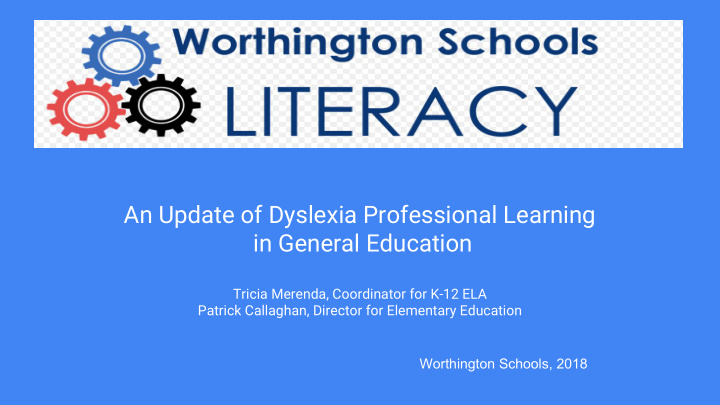



An Update of Dyslexia Professional Learning in General Education Tricia Merenda, Coordinator for K-12 ELA Patrick Callaghan, Director for Elementary Education Worthington Schools, 2018
As a district, we define reading as a meaning making, problem solving process that relies on thinking in order to make sense of text. Our goal is that all students are successful in decoding and using text to support their thinking and sense making. To that end, our reading instructional framework includes each of the following building blocks critical to effective reading and meaning-making: Phonemic Awareness ● ● Phonics ● Fluency Vocabulary ● Comprehension ●
What is Dyslexia? “ Dyslexia is a specific learning disability that is neurobiological (brain-based) in origin. It is characterized by difficulties with accurate and/or fluent word recognition and by poor spelling and decoding abilities. These difficulties typically result from a deficit in the phonological component of language that is often unexpected in relation to other cognitive abilities and the provision of effective classroom instruction. Secondary consequences may include problems in reading comprehension and reduced reading experience that can impede growth of vocabulary and background knowledge.” International Dyslexia Association
Our Understandings . . . Based on the definitions of Dyslexia, we understand that: ● Dyslexia is brain-based and may be inherited. ● Dyslexia specifically impairs a person’s ability to read. ● The disorder varies from person to person. ● Phonological processing (manipulation of sounds), decoding, fluent word reading, spelling, and/or rapid visual-verbal responding are common challenges.
Interant
Timeline of Highlights to Address Reading Challenges Related to Dyslexia 2011 -Wilson Language training and certification initiated with Special Education staff and continues to present day 2014 -Developed our word study scope and sequence -Fundations adopted k-2 as our primary instructional resource for early literacy word work -Words their Way adopted as our primary instructional resource for grades 3-6 2015 - Introduced Developmental Spelling Inventory in intermediate grades - K-8 teachers trained in use of Benchmark Assessment System for observing/measuring student performance in all reading areas -- used for instructional planning. -Intensive work with re-familiarizing elementary staff with all components of the framework and how they work together.
Timeline... continued 2016 -Piloted new universal screeners for Phonics with students in grades 1 and 2 -Piloted an intense phonics reading intervention with our reading specialists -Elementary Instructional Coaches and Principals receive in-depth reading training - In district trainer, certified by IDA, to support teacher in phonics instruction - Foundations HS class adopted 2017 - All Reading Specialists received intense training on Phonics intervention implementation - Phonics Screeners reviewed and revised
2017-2018 School Year Feb/March, 2018 -Productive dialogue with parents of Dyslexic students begin May 2018 -Kindergarten Phonics Screeners developed for fall implementation Spring 2018 -Reading Instruction in the Worthington Schools brochure drafted (for all parents K-2) -Reading Specialists met with Sutter Park teachers to review student data on language Summer 2018 - Reading brochure finalized with feedback from parent focus group - District Process Maps developed for assessing and supporting students with reading challenges, specifically Dyslexia - Fundations Curriculum Maps developed in K-2
Current School Year August, 2018 - All elementary staff provided “Dyslexia in the Classroom: What Every Teacher Needs to Know” - Intensive professional learning focused on Dyslexia and Phonics Instruction provided to all Kindergarten teachers. -District Elementary Assessment Folders updated to include specific data related to Phonics and Word Work for fall, winter, and spring. -Elementary Assessment Protocols implemented with expectations for data documentation and timelines August/September, 2018 -Reading brochure provided to parents in grades K-2; posted on district website -September staff meetings in elementary schools focused on professional learning about Dyslexia in all grade levels -Updated Phonics Screeners implemented in K-2 -Staff professional learning for grades 1-2 provided by collaboration between the District Certified Dyslexia Specialist and ELA Coordinator
Next Steps ● Ongoing collection, review, analysis of data related to our early screeners for progress monitoring of our enhanced work Planning a workshop for parents of incoming kindergarten students to ● share our instructional framework for reading and provide suggestions for how parents can help their students’ readiness for school ● Evaluation of resources that could be shared with families of incoming K students who may not have had the benefit of preschool Continued and ongoing professional learning support for staff related to ● Dyslexia and other reading disabilities.
Questions
Reference Carolyn D. Cowen, Ed.M., International Dyslexia Association- Structured Literacy graphic. Retrieved from https://dyslexiaida.org/what-is-structured-literacy/
Recommend
More recommend